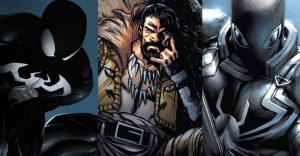Passion of the Christ: Every Scene NOT From The Bible (& Why They Were Included)

Mel Gibson’s 2004 The Passion of the Christ included a lot of scenes that aren’t from the Bible at all. Directed by Mel Gibson, The Passion of the Christ was that rare thing: an R-rated movie that was largely embraced by Christian audiences. It’s still the highest-grossing R-rated film of all time in the domestic box office, with only Deadpool offering any competition at all.
Gibson frequently claimed he was only inspired by scripture, but that’s not entirely accurate. In some cases, he deployed dramatic license for artistic effect, emphasizing the duplicity of the Pharisees by showing money changing hands as they attempt to hire witnesses against Jesus. Meanwhile, Gibson also drew on visions from Catholic visionaries such as Mary of Jesus of Ágreda (1602-1665) and Anne Catherine Emmerich (1774-1824). He found the latter particularly inspirational, because she had experienced detailed visions in which she gave a vivid account of crucifixion, as well as additional roles played by Jesus’ mother Mary. These were perfect for visual embellishment of the story, and they influenced even some of the Biblically-based scenes, such as the whipping of Jesus.
However, a number of scenes in The Passion of the Christ are completely foreign to scripture, and will surprise non-Catholic viewers who aren’t familiar with Mary of Jesus of Ágreda and Anne Catherine Emmerich. The following is a guide to the scenes not found in the Bible, and where they came from.
Jesus Invents Tables & Chairs

The most egregious example of Mel Gibson adding content in The Passion of the Christ: a flashback scene that shows Jesus inventing a table. The scene references Jesus working as a carpenter, providing for his mother’s needs. Little is known of Jesus’ life between his childhood and the beginning of his public ministry, but he’s believed to have apprenticed to his father as a carpenter, and practiced the family business until he reached the age of 30. Gibson imagines a strange scene in which Jesus invents tables and chairs, which are far from historically accurate. This is entirely fictional, serving to establish the closeness of the relationship between Jesus and his mother Mary, and it has the added benefit of hinting Jesus’ Divine knowledge informed him all his life.
Mary Magdalene as the Woman Caught in Adultery

Another flashback in The Passion of the Christ retells one of the most powerful scenes in the Gospel. In this scene, Jesus is confronted about a woman who had been caught in adultery, and — as the law mandated — he was offered the chance to begin stoning her to death. He refuses to do so, instead scrawling something mysterious in the sand and inviting anyone who is without sin to cast the first stone. This appears to have been one of the early Church’s favorite accounts of Jesus, demonstrating his characters and his grace, because he alone was perfect and thus had the right to cast that stone. The Passion of the Christ portrays this scene using Monica Bellucci’s Mary Magdalene; however, the Bible never specifies that the adulterous woman is Mary Magdalene, Jesus’ devout apostle. The conflation of these two Biblical women is a Catholic tradition, one questioned today by modern Bible scholars.
The Garden of Gethsemane Is Transformed Into A Temptation

In the Bible, Jesus heads to the Garden of Gethsemane to pray in order to prepare for the Cross. Anne Catherine Emmerich recast this as a moment of temptation, envisioning the Devil as present, attempting to persuade Jesus not to go to the Cross, and Gibson follows that pattern. He presents Jesus resisting the temptation, and crushing a serpent beneath his heel in quite a heavy-handed allusion to Genesis 3: 15, the first Messianic prophesy in the Bible. This scene strikes at an interesting theological tension in the Bible because some verses suggest the Devil did indeed initially attempt to persuade Jesus to avoid the Cross, particularly Mark 8: 33; when Jesus committed to his death regardless, Satan attacked him with all the force he could muster (Colossians 2: 15).
Additional Scenes For Judas Iscariot

The Passion of the Christ heavily adapts the story of Judas Iscariot, emphasizing that Judas was manipulated into betraying Jesus by Satan. When Judas comes to greet Jesus in the Garden, he is at the head of a large number of Jewish temple guards. In reality, political and religious tensions in Israel would have meant the Romans would never have allowed the Jews to assemble anything like this kind of private army. According to the Gospels, Judas was accompanied by a large crowd of men armed with swords and clubs (Matthew 26: 47, Mark 14: 43).
Later, the guilt-stricken Judas is confronted by the man he has betrayed when Jesus falls down the side of the bridge. Later, the suicide of Judas is embellished in a shocking and dramatic way, with Judas taunted by Satan and a group of demonic children. Gibson’s portrayal of Judas is heavily influenced by the visions of Mary of Jesus of Ágreda.
Mary Watches As Jesus Is Whipped

As Jesus is being tortured, his mother Mary awakens with fear in her heart. This is from the Dolorous Passion of Anne Catherine Emmerich (written by poet Clemens Brentano, who interviewed Emmerich) which reads, “During this agony of Jesus, I saw the Blessed Virgin also overwhelmed with sorrow and anguish of soul… I saw these interior movements of her soul towards Jesus… I beheld the spiritual communication which they had with each other.” Mary rushed to be with her son, and watched as he was whipped; in Anne Catherine Emmerich’s account, the wife of Pontius Pilate took sympathy on her, and gave her a linen cloth. When Jesus was taken away from the whipping-yard, Mary used the cloth to mop up the blood of her son.
Pilate’s wife plays a far less significant role in the Biblical accounts. In Matthew 27: 19, Pilate’s wife has a nightmarish dream and warns her husband to have nothing to do with what is happening to Jesus, but that is the limit of her participation in the Crucifixion narrative. This particular aspect of The Passion of the Christ has actually been surprisingly controversial because it creates a very positive image of Pilate and his wife, even though Pilate himself was something of a brutal tyrant in historical accounts.
The Passion of the Christ Includes Saint Veronica

The Passion of the Christ includes one scene in which an unnamed woman mops Jesus’ face, with her cloth is marked with an image of Christ’s face. This is the Catholic Saint Veronica, who is only mentioned in extra-Biblical accounts, and who was featured prominently in Anne Catherine Emmerich’s visions. She is the patron saint of French craftsmen called mulquiniers, as well as of photographers.
About The Author

















